
The United States Pacific Fleet (USPACFLT) is a theater-level component command of the United States Navy, located in the Pacific Ocean. It provides naval forces to the Indo-Pacific Command. Fleet headquarters is at Naval Station Pearl Harbor, Hawaii, with large secondary facilities at North Island, San Diego Bay on the Mainland.

The Battle of Cape Matapan was a naval battle during the Second World War between the Allies, represented by the navies of the United Kingdom and Australia, and the Royal Italian navy, from 27 to 29 March 1941. Cape Matapan is on the south-western coast of the Peloponnesian Peninsula of Greece.

The Home Fleet was a fleet of the Royal Navy that operated from the United Kingdom's territorial waters from 1902 with intervals until 1967.

USS Arleigh Burke (DDG-51), named for Admiral Arleigh A. Burke, USN (1901–1996), is the lead ship of the Arleigh Burke-class guided missile destroyers. She was laid down by the Bath Iron Works company at Bath, Maine, on 6 December 1988, and launched on 16 September 1989 by Mrs. Roberta (Gorsuch) Burke. The Admiral was present in person at her commissioning ceremony on 4 July 1991, which was held on the waterfront in downtown Norfolk, Virginia.

USS Arthur W. Radford (DD-968) was a Spruance-class destroyer in the United States Navy. She was named for Admiral Arthur W. Radford USN (1896–1973), the first naval officer to be Chairman of the Joint Chiefs of Staff.
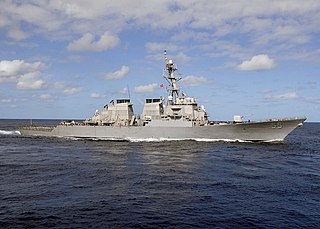
USS Stout (DDG-55) is the fifth Arleigh Burke-class guided missile destroyer. Built for the United States Navy by Ingalls Shipbuilding, she was commissioned on 13 August 1994 and she is currently home-ported in Naval Station Norfolk. She is part of Destroyer Squadron 26. Stout is named for Rear Admiral Herald F. Stout, who distinguished himself as the Commanding Officer of the destroyer USS Claxton during World War II. In November 1943, Commander Stout received two Navy Crosses in the span of three weeks for his actions in the Pacific. Stout aided Destroyer Squadron 23 in sinking five heavily armed Japanese warships and damaging four others during the Solomon Islands campaign as well as sinking four more Japanese warships and damaging two others to establish a beachhead on Bougainville Island. Stout was ordered on 13 December 1988, the keel was laid down on 8 August 1991, she was launched on 16 October 1992 and commissioned on 13 August 1994. As of July 2020 the ship is part of Destroyer Squadron 26 based out of Naval Station Norfolk.

The Battle of Calabria, known to the Italian Navy as the Battle of Punta Stilo, was a naval battle during the Battle of the Mediterranean in the Second World War. Ships of the Italian Regia Marina were opposed by vessels of the British Royal Navy and Royal Australian Navy. The battle occurred 30 miles to the east of Punta Stilo, Calabria, on 9 July 1940. It was one of the few pitched battles of the Mediterranean campaign during the Second World War involving large numbers of ships on both sides. Both sides claimed victory, but in fact the battle was a draw and everyone returned to their bases safely.

The Soviet Navy was the naval warfare uniform service branch of the Soviet Armed Forces. Often referred to as the Red Fleet, the Soviet Navy made up a large part of the Soviet Union's strategic planning in the event of a conflict with the opposing superpower, the United States, during the cold war period between the two countries. The Soviet Navy played a large role during the Cold War (1945-1991), either confronting the North Atlantic Treaty Organisation in western Europe or power projection to maintain its sphere of influence in eastern Europe.

HMS Euryalus was a Dido-class cruiser of the Royal Navy. She was laid down at Chatham Dockyard on 21 October 1937, launched on 6 June 1939, and commissioned 30 June 1941. Euryalus was the last cruiser built at the dockyard.
A destroyer squadron is a naval squadron or flotilla usually consisting of destroyers rather than other types of vessel. In some navies other vessels, such as frigates, may be included. In English the word "squadron" tends to be used for larger and "flotilla" for smaller vessels; both may be used for destroyer units. Similar formations are used in non-English-speaking countries, e.g., the "escadrille"—which would translate directly as "squadron"—in France.
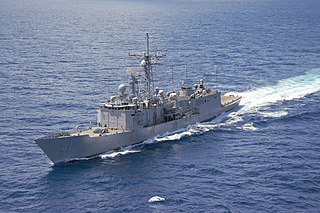
USS McClusky (FFG-41) was a Oliver Hazard Perry-class frigate of the United States Navy. She was named for Rear Admiral C. Wade McClusky (1902–1976) who as a lieutenant commander led the air group of USS Enterprise, which sank the Japanese carriers Kaga and Akagi during the Battle of Midway. McClusky later served as part of Destroyer Squadron 1, and after 31 years of service, was decommissioned on 14 January 2015 at Naval Base San Diego.

USS Cascade (AD-16), the only ship of its class, was a destroyer tender in the United States Navy.
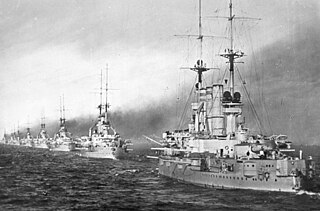
A squadron, or naval squadron, is a significant group of warships which is nonetheless considered too small to be designated a fleet. A squadron is typically a part of a fleet. Between different navies there are no clear defining parameters to distinguish a squadron from a fleet, and the size and strength of a naval squadron varies greatly according to the country and time period. Groups of small warships, or small groups of major warships, might instead be designated flotillas by some navies according to their terminology. Since the size of a naval squadron varies greatly, the rank associated with command of a squadron also varies greatly.

The first USS Halsey, a Leahy-class guided missile cruiser was a ship of the United States Navy named in honor of Fleet Admiral William Halsey. Originally called a destroyer leader or frigate (DLG-23), on 30 June 1975 she was redesignated a cruiser (CG-23) in the U.S. Navy's ship reclassification.

Destroyer Squadron 23 is a squadron of United States Navy destroyers and frigates based out of San Diego, California. The squadron is best known for its actions during World War II, most notably the Battle of Cape St. George, under the command of then-Commodore Arleigh Burke. Currently, the DESRON is assigned to Carrier Strike Group Nine, which includes USS Theodore Roosevelt (CVN-71), USS Cape St. George (CG-71) and Carrier Air Wing Eleven.

The 3rd Battle Squadron was a naval squadron of the British Royal Navy consisting of battleships and other vessels, active from at least 1914 to 1945. The 3rd Battle Squadron was initially part of the Royal Navy's Home Fleet. During the First World War, the Home Fleet was renamed the Grand Fleet. During the Second World War, the squadron covered Atlantic convoys.

The Pacific Fleet is the Russian Navy fleet in the Pacific Ocean.
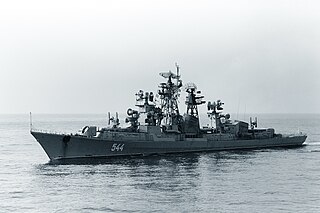
Sposobny was a Project 61 destroyer of the Soviet Navy, which briefly became part of the Russian Navy. The ship served during the Cold War from 1971 to 1989.
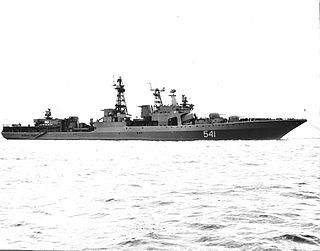
Admiral Zakharov was a Udaloy-class destroyer of the Russian Navy.

Gordy was the eighth ship of the Kanin-class destroyer of the Soviet Navy.



















